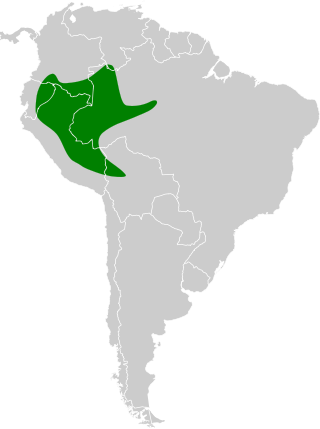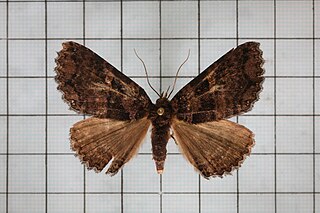
The Calpinae are a subfamily of moths in the family Erebidae described by Jean Baptiste Boisduval in 1840. This subfamily includes many species of moths that have a pointed and barbed proboscis adapted to piercing the skins of fruit to feed on juice, and in the case of the several Calyptra species of vampire moths, to piercing the skins of mammals to feed on blood. The subfamily contains some large moths with wingspans longer than 5 cm (2 in).

The chestnut-headed partridge is a bird species in the family Phasianidae. It is found in highland forest in Cambodia, specifically the Cardamom Mountains. Some taxonomists consider the Siamese partridge conspecific.

The undulated antshrike is a species of bird in subfamily Thamnophilinae of family Thamnophilidae, the "typical antbirds". It is found in Bolivia, Brazil, and Peru.
Peraclidae is a family of pelagic sea snails or "sea butterflies", marine gastropod mollusks in the superfamily Cymbulioidea.

Leonard Plukenet (1641–1706) was an English botanist, Royal Professor of Botany and gardener to Queen Mary.

Tetrarhanis is a genus of butterflies in the family Lycaenidae. The species of this genus are endemic to the Afrotropical realm.

Carebara diversa, the East Indian harvesting ant, is a species of marauder ant widely distributed throughout Asia.

Sypna is a genus of moths in the family Erebidae. The genus was erected by Achille Guenée in 1852.

Catocala diversa is a moth of the family Erebidae first described by Carl Geyer in 1826. It is found in Spain, south-eastern France, Italy, the Balkans, European southern Russia and Israel.
Hynhamia is a genus of moths belonging to the family Tortricidae.

Psittacodrillia diversa is a species of sea snail, a marine gastropod mollusk in the family Horaiclavidae.

Zafrona is a genus of sea snails, marine gastropod mollusks in the family Columbellidae, the dove snails.
Tetrarhanis diversa, the diverse on-off, is a butterfly in the family Lycaenidae. It is found in Guinea, Sierra Leone, Liberia and Ivory Coast. The habitat consists of primary forests.
Hynhamia diversa is a species of moth of the family Tortricidae. It is found in Ecuador.

Luperina dumerilii, or Dumeril's rustic, is a moth of the family Noctuidae. The species was first described by Philogène Auguste Joseph Duponchel in 1826. It is found in the Mediterranean region and warmer areas of central and south-eastern Europe. Strays have been recorded from southern England. It is also present in Turkey and Jordan.
The Siamese partridge is a bird species in the family Phasianidae. It is found in highland forest in eastern Thailand. Some taxonomic authorities consider it to be a subspecies of the chestnut-headed partridge.
Clepsis diversa is a species of moth of the family Tortricidae. It is found in Nuevo León, Mexico.
Thereva diversa is a species of stiletto flies in the family Therevidae.

Calligrapha diversa is a species of leaf beetle in the family Chrysomelidae. It was first described by Carl Stål in 1859. It is found across Central America and North America. It feeds on plants in the family Malvaceae, such as Malva parviflora andSphaeralcae angustifolia, and Solanaceae like Solanum nigrescens.

Nemocardium is a genus of bivalves belonging to the family Cardiidae.













